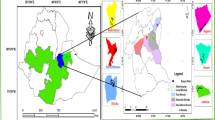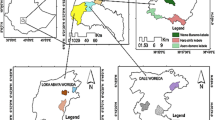Abstract
Tropical deforestation and forest degradation have resulted in substantial losses of goods and services and a decline in the quality of life. Agroforestry is a viable land-use option to counteract such declines in ecosystem services, including biodiversity and supporting local livelihoods. However, it is unclear how socioecological factors mediate these roles, which hinders the implementation of initiatives to conserve biodiversity. This study aimed to investigate perennial plant species composition and diversity in relation to socioecological variables and agroforestry practices in central Ethiopia. The vegetation data were collected from 243 sample farms that belonged to 81 randomly chosen households from nine kebeles. Across all practices, 92 plant species from 75 genera and 46 families were identified. Of these, 77% were native plant species, and the remaining were exotic ones. Margalef species richness and the Shannon diversity index were both significantly higher (p < 0.05) in homegardens and middle elevations. Furthermore, species richness and the Shannon diversity index were positively and significantly related to slope, farm size, farm age, and wealth status. Parklands, lowland altitude, and younger farms had the highest Simpson’s evenness, whereas wealth status, farm size, and slope had no significant association with Simpson’s evenness. Overall, this study showed that agroforestry serves as a refuge for native species and helps reverse species loss in natural forests. However, native species are gradually being replaced with exotic species, compromising the integrity of agricultural landscapes. Our study also emphasizes the urgent need to consider socioecological factors when examining biodiversity and planning agricultural landscape management strategies.






Similar content being viewed by others
References
Abide EB, Asfaw Z (2022) On-farm tree species diversity and management in semi-arid of Lemo district, Southern Ethiopia. Agrofor Syst 96:1–12
Akpalu SE, Anglaaere L, Damnyag L et al (2022) Floristic composition of agroforestry parklands in the semi-arid zone of Ghana: A special focus on Faidherbia albida (Delile) A. Chev. Trees for People 9:100310
Akter R, Kamrul M, Kabir KH, Darr D (2022) Trees, forests and people agroforestry systems and their impact on livelihood improvement of tribal farmers in a tropical moist deciduous forest in Bangladesh. Trees for People 9:100315. https://doi.org/10.1016/j.tfp.2022.100315
Beyene AD, Mekonnen A, Randall B, Deribe R (2019) Household level determinants of agroforestry practices adoption in rural Ethiopia. For Trees Livelihoods 28:194–213
Carsan S, Stroebel A, Dawson I et al (2014) Can agroforestry option values improve the functioning of drivers of agricultural intensification in Africa? Curr Opin Environ Sustain 6:35–40. https://doi.org/10.1016/j.cosust.2013.10.007
Death R (2008) Margalef’s index. Encycl Ecol Five-Volume Set 1:2209–2210. https://doi.org/10.1016/B978-008045405-4.00117-8
Edwards S, Tadesse M, Hedberg I (1995) Flora of Ethiopia and Eritrea, volume 2, part 2: Canellaceae to Euphorbiaceae. Uppsala National Herb Addis Ababa Ethiopia Dep Syst Bot
Etana B, Atickem A, Tsegaye D et al (2021) Traditional shade coffee forest systems act as refuges for medium-and large-sized mammals as natural forest dwindles in Ethiopia. Biol Conserv 260:109219
Eyasu G, Tolera M, Negash M (2020) Heliyon Woody species composition, structure, and diversity of homegarden agroforestry systems in southern Tigray, northern Ethiopia. Heliyon 6:e05500. https://doi.org/10.1016/j.heliyon.2020.e05500
Fordjour PA, Rahmad EKBZB (2021) Logging and topographic effects on tree community structure and habitat associations in a tropical upland evergreen forest, Ghana. J for Res 32:1361–1372. https://doi.org/10.1007/s11676-020-01203-w
Getachew E, Lemessa D (2021) Socio-ecological determinants of species composition of crops in homegardens of southern Ethiopia. Agrofor Syst. https://doi.org/10.1007/s10457-021-00681-z
Goded S, Ekroos J, Domínguez J et al (2019) Effects of eucalyptus plantations on avian and herb species richness and composition in North–West Spain. Glob Ecol Conserv 19:e00690
Haile G, Lemenih M, Senbeta F, Itanna F (2017) Plant diversity and determinant factors across smallholder agricultural management units in Central Ethiopia Plant diversity and determinant factors across smallholder agricultural management units in Central Ethiopia. Agrofor Syst 91:677–695. https://doi.org/10.1007/s10457-016-0038-5
Hedberg I, Edwards S (1989) Flora of Ethiopia, volume 3: Pittosporaceae to Araliaceae. The National Herbarium, Addis Ababa University and Uppsala University, Addis Ababa, Uppsala
Hedberg I, Kelbessa E, Edwards S, Demissew S, Persson E (2006) Flora of Ethiopia and Eritrea, volume 5: gentianaceae to cyclocheilaceae. The National Herbarium, Addis Ababa, Ethiopia, Department of Systematic Botany, Addis Ababa, Uppsala
Jaureguiberry P, Titeux N, Wiemers M et al (2022) The direct drivers of recent global anthropogenic biodiversity loss. Sci Adv 8:eabm9982. https://doi.org/10.1126/sciadv.abm9982Jaureguiberry
Kanta S, Maraseni T, Prasad Y, Parajuli R (2021) Forest policy and economics species composition, diversity, and carbon stock in trees outside forests in middle hills of Nepal. For Policy Econ 125:102402. https://doi.org/10.1016/j.forpol.2021.102402
Kassa G, Bekele T, Demissew S, Abebe T (2022) Above- and belowground biomass and biomass carbon stocks in homegarden agroforestry systems of different age groups at three sites of southern and southwestern Ethiopia. Carbon Manag 13:531–549. https://doi.org/10.1080/17583004.2022.2133743
Kaswanto RL, Nakagoshi N (2014) Landscape ecology-based approach for assessing pekarangan condition to preserve protected area in west java. Des Low Carbon Soc Landsc. https://doi.org/10.1007/978-4-431-54819-5
Kebede Y, Baudron F, Bianchi FJJA, Tittonell P (2019) Drivers, farmers’ responses and landscape consequences of smallholder farming systems changes in southern Ethiopia. Int J Agric Sustain 17:383–400
Legesse A, Negash M (2021) Heliyon Species diversity, composition, structure and management in agroforestry systems: the case of Kachabira district, Southern Ethiopia. Heliyon 7:e06477. https://doi.org/10.1016/j.heliyon.2021.e06477
Li C, Chen X, Jiang A et al (2021) Socioeconomic determinants of crop diversity and its effect on farmer income in guangxi, Southern China. Agriculture 11:1–15. https://doi.org/10.3390/agriculture11040336
Mairura FS, Musafiri CM, Kiboi MN et al (2022) Farm factors influencing soil fertility management patterns in Upper Eastern Kenya. Environ Chall 6:100409. https://doi.org/10.1016/j.envc.2021.100409
Malavasi M, Santoro R, Cutini M et al (2016) The impact of human pressure on landscape patterns and plant species richness in Mediterranean coastal dunes. Plant Biosyst Int J Deal All Asp Plant Biol 150:73–82
Manaye A, Tesfamariam B, Tesfaye M et al (2021) Tree diversity and carbon stocks in agroforestry systems in northern Ethiopia. Carbon Balance Manag 16:1–10. https://doi.org/10.1186/s13021-021-00174-7
Mathewos M, Hundera K, Biber-freudenberger L (2018) Planting fruits and vegetables in homegarden as a way to improve livelihoods and conserve plant biodiversity. Agriculture. https://doi.org/10.3390/agriculture8120190
Mohan S, Nair PKR, Long AJ (2007) An assessment of ecological diversity in homegardens: a case study from Kerala State, India. J Sustain Agric 29:135–153
Morris EK, Caruso T, Buscot F et al (2014) Choosing and using diversity indices: Insights for ecological applications from the German biodiversity exploratories. Ecol Evol 4:3514–3524. https://doi.org/10.1002/ece3.1155
Mosquera-Losada MR, Santiago-Freijanes JJ, Rigueiro-Rodríguez A et al (2020) The importance of agroforestry systems in supporting biodiversity conservation and agricultural production: a European perspective. Reconciling agricultural production with biodiversity conservation. Burleigh Dodds Science Publishing, Cambridge, pp 243–258
Nath B, Ni-Meister W (2021) The interplay between canopy structure and topography and its impacts on seasonal variations in surface reflectance patterns in the boreal region of Alaska—implications for surface radiation budget. Remote Sens 13:3108
Ndayambaje JD, Heijman WJM, Mohren GMJ (2013) Farm woodlots in rural Rwanda: purposes and determinants. Agrofor Syst 87:797–814
Negash M, Yirdaw E, Luukkanen O (2012) Potential of indigenous multistrata agroforests for maintaining native floristic diversity in the south-eastern Rift Valley escarpment. Ethiopia. https://doi.org/10.1007/s10457-011-9408-1
Negash M, Starr M (2021) Litter decomposition of six tree species on indigenous agroforestry farms in south-eastern Ethiopia in relation to litterfall carbon inputs and modelled soil respiration. Agrofor Syst 95:755–766. https://doi.org/10.1007/s10457-021-00630-w
Negash M, Starr M, Kanninen M, Berhe L (2013) Allometric equations for estimating aboveground biomass of Coffea arabica L. grown in the Rift Valley escarpment of Ethiopia. Agrofor Syst 87:953–966
Reed SC, Reibold R, Cavaleri MA et al (2020) Soil biogeochemical responses of a tropical forest to warming and hurricane disturbance. Advances in ecological research. Elsevier, Amsterdam, pp 225–252
Reppin S, Kuyah S, Rosenstock TS et al (2020) Contribution of agroforestry to climate change mitigation and livelihoods in Western Kenya. Agrofor Syst 94:203–220. https://doi.org/10.1007/s10457-019-00383-7
Samuel D, Derero A, Hadgu KM (2019) Tree species diversity and spatial distribution patterns on agricultural landscapes in sub-humid Oromia. Ethiopia 93:1015–1029. https://doi.org/10.1007/s10457-018-0197-7
Shumi G, Dorresteijn I, Schultner J et al (2019) Woody plant use and management in relation to property rights: a social-ecological case study from southwestern Ethiopia. Ecosyst People 15:303–316. https://doi.org/10.1080/26395916.2019.1674382
Singh M, Kumar A, Sharma M (2021) Conservation of wildlife diversity in agroforestry systems in eastern Himalayan biodiversity hotspot. Proceedings of the zoological society. Springer, New York, pp 171–188
Solomon N, Hishe H, Annang T et al (2018) Forest cover change, key drivers and community perception in Wujig Mahgo Waren forest of northern Ethiopia. Land 7:32
Spescha V, Aráoz E (2021) Socio-economic differences control species composition of urban gardens in a Metropolitan area of Argentina
Tadele M, Birhane E, Kidu G et al (2020) Contribution of parkland agroforestry in meeting fuel wood demand in the dry lands of Tigray, Ethiopia. J Sustain for 39:841–853
Tadesse E (2021) Impacts of traditional agroforestry practices, altitudinal gradients and households’ wealth status on perennial plants species composition, diversity, and structure in south-central. Agrofor Syst 95:1533–1561. https://doi.org/10.1007/s10457-021-00659-x
Tadesse E, Abdulkedir A, Khamzina A et al (2019) Contrasting species diversity and values in home gardens and traditional parkland agroforestry systems in ethiopian sub-humid lowlands. Forests. https://doi.org/10.3390/F10030266
Teklu B, Gerrie M, Ken WJVDV (2018) Home garden system dynamics in Southern Ethiopia. Agrofor Syst 92:1579–1595. https://doi.org/10.1007/s10457-017-0106-5
Thangjam U (2021) Tree species diversity in relation to site quality and home gardens types of North–East India. Agrofor Syst. https://doi.org/10.1007/s10457-021-00715-6
Tiruneh Asaye Z (2017) Effects of scattered Acacia tortilis (Forssk) hayne on soil properties in different land uses in Central Rift Valley of Ethiopia. J Sustain for 36:164–176
Titeux N, Wiemers M et al (2022) The direct drivers of recent global anthropogenic biodiversity loss. Sci Adv 8:eabm9982. https://doi.org/10.1126/sciadv.abm9982
Trisos CH, Merow C, Pigot AL (2020) The projected timing of abrupt ecological disruption from climate change. Nature 580:496–501
Tsedeke RE, Dawud SM, Tafere SM (2021) Assessment of carbon stock potential of parkland agroforestry practice: the case of Minjar Shenkora, North Shewa, Ethiopia. Environ Syst Res. https://doi.org/10.1186/s40068-020-00211-3
Whittaker RJ (1993) Holocene book reviews: vegetation description and analysis: a practical approach M. Kent and P. Coker. Belhaven Press, London 1992, p 363. ISBN 1-85293-006-3. The Holocene 3:379
Woldu G, Solomon N, Hishe H et al (2020) Topographic variables to determine the diversity of woody species in the exclosure of Northern Ethiopia. Heliyon 6:e03121. https://doi.org/10.1016/j.heliyon.2019.e03121
Acknowledgements
We are grateful to Wondo Genet College of Forestry and Natural Resources, Hawassa University, Ambo University, and Czech University of Life Sciences for providing financial support for this study.
Funding
This study was supported by Wondo Genet College of Forestry and Natural Resources, Hawassa University, Ambo University, and Czech University of Life Sciences.
Author information
Authors and Affiliations
Corresponding author
Ethics declarations
Conflict of interest
The authors declare that they have no conflict of interest.
Additional information
Publisher's Note
Springer Nature remains neutral with regard to jurisdictional claims in published maps and institutional affiliations.
Supplementary Information
Below is the link to the electronic supplementary material.
Rights and permissions
Springer Nature or its licensor (e.g. a society or other partner) holds exclusive rights to this article under a publishing agreement with the author(s) or other rightsholder(s); author self-archiving of the accepted manuscript version of this article is solely governed by the terms of such publishing agreement and applicable law.
About this article
Cite this article
Demie, G., Negash, M., Asrat, Z. et al. Perennial plant species composition and diversity in relation to socioecological variables and agroforestry practices in central Ethiopia. Agroforest Syst 98, 461–476 (2024). https://doi.org/10.1007/s10457-023-00924-1
Received:
Accepted:
Published:
Issue Date:
DOI: https://doi.org/10.1007/s10457-023-00924-1




